Heritage Trail, 05 June 2006
Laurel reflects on our outing at the Heritage Trail...

Ginny, Kat and I are on the Heritage Trail. It’s breezy, high seventies, and much more comfortable than the last walk Kat and I took when the heat index was in the nineties. We related to Ginny a tale of that sweat-fest as we unloaded our gear...
As we approached the railroad bridge over a stream, I’d spotted a large black creature making its way through the underbrush. About thirty feet away and below where we stood on the embankment, it was hard to make out. Was it a baby bear? Could it be a beaver? The poison ivy and jewelweed at the water’s edge soon parted to reveal its identity. A huge snapping turtle lumbered from its cover as it moved toward the water.
A later peek at the field guide revealed that these creatures top out at around eighteen inches in carapace length. This one was closing in on the maximum. Kat left the trail while I watched the babies. She waded through the poison ivy with a later eruption of a single patch of blisters on her ankle the only price for some fine photographs.
The animal was not aggressive and did not display its characteristic threat stance—hissing menacingly, body lifted high on its thick legs. In fact, by the time Kat and I switched places and I’d tiptoed delicately between three-leaved dangers, he or she had already buried half its body beneath the browned, downward resting blades of a tussock sedge. I could only see its nostrils on the front end, but its heavily armored tail was clearly visible. Male snapping turtles are supposed to have longer tails than females, but without one of each for comparison, we were unable to make the call.
We didn’t expect the snapper to make a repeat appearance for Ginny and her four month old, Sawyer, but were looking forward to whatever came our way. Luckily, the weedy railbed was hopping with action. Very soon I glimpsed what may have been a yellow spotted forester, a day flying moth. It, too, headed for a patch of poison ivy, and I knew better than to follow.
Although Kat is the better net wielder, this day I was the only one armed. I brought a children’s butterfly net with a short handle that does not stick out too far from the basket under my stroller to trip me up.
A later peek at the field guide revealed that these creatures top out at around eighteen inches in carapace length. This one was closing in on the maximum. Kat left the trail while I watched the babies. She waded through the poison ivy with a later eruption of a single patch of blisters on her ankle the only price for some fine photographs.
The animal was not aggressive and did not display its characteristic threat stance—hissing menacingly, body lifted high on its thick legs. In fact, by the time Kat and I switched places and I’d tiptoed delicately between three-leaved dangers, he or she had already buried half its body beneath the browned, downward resting blades of a tussock sedge. I could only see its nostrils on the front end, but its heavily armored tail was clearly visible. Male snapping turtles are supposed to have longer tails than females, but without one of each for comparison, we were unable to make the call.
We didn’t expect the snapper to make a repeat appearance for Ginny and her four month old, Sawyer, but were looking forward to whatever came our way. Luckily, the weedy railbed was hopping with action. Very soon I glimpsed what may have been a yellow spotted forester, a day flying moth. It, too, headed for a patch of poison ivy, and I knew better than to follow.
Although Kat is the better net wielder, this day I was the only one armed. I brought a children’s butterfly net with a short handle that does not stick out too far from the basket under my stroller to trip me up.
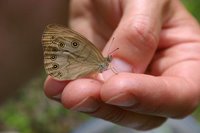
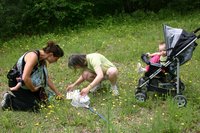
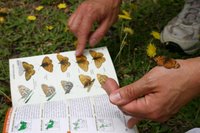
I chased several intriguing subjects and was soon three for three: First a butterfly we thought might be the familiar little wood satyr, but this one had too many spots on the reverse of the wings—an eyed brown! Second an American lady conveniently appeared as if to let us learn the difference between it and the painted lady we’d caught on the last, sweltering walk. Finally, out of the woods and right into my net flew a huge ichneumon wasp. Its buzzing had alerted me to its approach, and I’d hardly lifted the net when it bumbled in, so I could not claim any increase in skill.
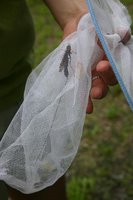
The ichneumon’s impressive ovipositor worried my companions. Could that four inch long spike attached to the large wasp’s abdomen be a stinger? Thankfully, for humans at least, it is more like a drill, able to penetrate bark and lay eggs in larvae hiding within the wood.
I tried to release the wasp from the net slowly so the others, who unlike me, remembered their cameras, could get a shot, but it slipped through my fingers, ovipositor flexible and feeling plastic to the touch.
We passed several open snapping turtle nests with shell debris scattered about and two intact eggs in one. It is egg laying season. Last visit we saw turtle tracks and shell and tail drags crossing the trail and evidence of several false nests. I hold my tongue; many of these may have been dug up by nest predators rather than hatchlings. The painted turtles have been hatching out though; in May we heard reports from other walkers of baby turtles crossing the path, and we found a skeletonized specimen beside the path.
Farther along the trail, Ginny spots something moving in the yellow hawkweed. I took off in the direction she pointed and netted a snowberry clearwing, a day flying moth with a huge, fuzzy body and clear wings. I showed it to my toddler. She got very excited and began to mimic our constant pointing. When she is on foot, she will stop at the sight of an ant, squat and point and say “bug, bug, bug!” I guess our excitement is infectious. We show them our joy in nature through our behavior.

As we strolled on, Sawyer sleeping in his sling, the babies happy in their strollers, Kat checked the tree holes she had spotted on an earlier trip hoping to catch an inhabitant on film.
The twins, Lily and Penelope, started getting fussy at the bridge where we had seen the snapping turtle. Kat and Ginny got some good shots of a couple of tiger swallowtails nectaring on a viburnum. We looked down into the river to see if the crayfish were active, but the surface of the water was not still and its shallow depth was impenetrable.
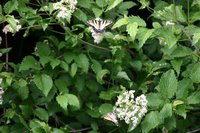
Increasing complaints required Kat to carry one baby in the front pack and the other in her arms. Luckily she had Ginny, baby in sling, available to push the stroller. As we rolled back to the parking lot, we were paralleled by a wild turkey and crossed paths with a woodchuck and a cottontail. The clock in my car said two hours had passed; it felt like we were just getting started.
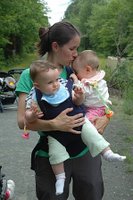

0 Comments:
Post a Comment
<< Home